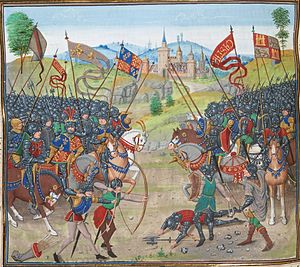Battle of Nájera
| Battle of Nájera (Navarrete) | |||||||
|---|---|---|---|---|---|---|---|
| Part of Castilian Civil War | |||||||
 The Battle of Nájera from a fifteenth-century manuscript of Froissart's Chronicles. The English and Peter of Castile are on the left. |
|||||||
|
|||||||
| Belligerents | |||||||
|
• • Other mercenaries: |
Other noblemen: Mercenaries: |
||||||
| Commanders and leaders | |||||||
|
|
|
||||||
| Strength | |||||||
|
Total: more than 10,000. 6,000 elite European mercenaries 2,000 Aquitaine soldiers 1,000 English soldiers 800 Castilian soldiers 500 English Longbowmen 300 Navarrese soldiers Troops from Majorca Henry deserters and other Spanish followers of King Peter. |
Total: more than 4,500 2,500 Castilian soldiers 1,000 elite French mercenaries 1,000 Aragonese soldiers Footsoldiers (escuderos de pie) |
||||||
| Casualties and losses | |||||||
| Unknown. Minor. | Heavy losses. Probably more than half of the army was killed or captured. | ||||||
The Battle of Nájera, also known as the Battle of Navarrete, was fought on 3 April 1367 near Nájera, in the province of La Rioja, Castile. It was an episode of the first Castilian Civil War which confronted King Peter of Castile with his half-brother Count Henry of Trastámara who aspired to the throne involving Castile in the international conflict of the Hundred Years' War. The Castilian naval power - far superior to that of France or England - would encourage these two Nations involved in the Hundred Years' War to take sides in the Castilian Civil War with the purpose of having the Castilian fleet at their disposal.
King Peter of Castile was supported by England, Aquitaine, Majorca, Navarra, and the best European mercenaries hired by the Black Prince. His rival Count Henry was aided by a majority of the nobility and the Christian military organizations in Castile and, while neither the Kingdom of France nor the Crown of Aragon gave him official assistance, he had on his side many Aragonese noblemen and the French free companies loyal to his Lieutenant the Breton knight and French commander Bertrand du Guesclin. Although the battle ended with a resounding defeat of Henry's side, it would have disastrous consequences for the King Peter, the Prince of Wales and England.
After the peace treaty favorable to England signed in 1360 during the Hundred Years' War, France was interested in avoiding open conflict with England and so tried to associate with Castile to tip the balance in its favor. Another problem that had France were the mercenaries of the great companies dedicated to pillage now that there was no war. In late 1365 Charles V of France, with the help of Pope Urban V, succeeded in averting temporarily most of the great companies. Under the pretext of carrying on a crusade against the Moorish Kingdom of Granada, the Pope paid for the expedition to Spain. Later on France and Aragon defrayed Henry in order to recruit these troops for his cause and so getting rid of the free companies in France and supporting the ascent to power in Castile of their favorite.
...
Wikipedia
